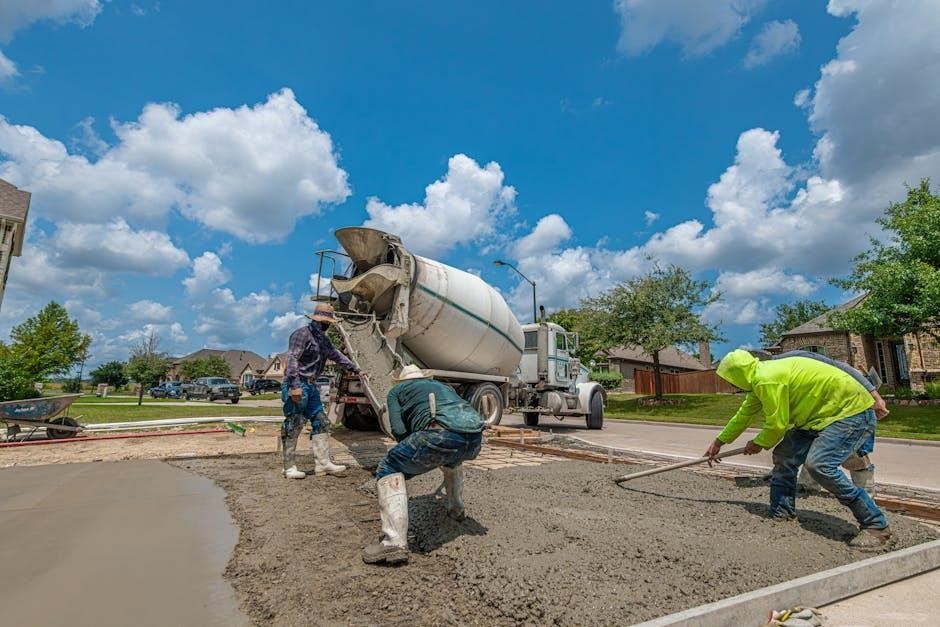Sakrete Concrete Mix offers pre-blended convenience, high strength, and durability for various projects. Their products, like Pro-Mix and Fast Set, cater to different needs, ensuring easy mixing and professional results with proper safety and techniques.

Product Overview
Sakrete offers a range of high-strength concrete mixes, including Pro-Mix, Fast Set, and PSI 6000, designed for durability and fast results in various construction and repair projects.
Types of Sakrete Concrete Mix
Sakrete offers various concrete mixes tailored for different projects. Their Pro-Mix line provides industrial-strength solutions, while Fast Set Concrete Mix ensures quick setting for time-sensitive tasks. The PSI 6000 mix delivers high strength for heavy-duty applications. Each type is formulated to meet specific needs, from rapid repairs to durable construction projects, ensuring versatility and reliability for professionals and DIYers alike. These mixes are designed to enhance work efficiency and provide long-lasting results across various concrete applications.
Applications and Uses of Sakrete Concrete Mix
Sakrete Concrete Mix is versatile for various projects, from residential to commercial. It’s ideal for constructing slabs, walkways, and deck supports, ensuring a solid foundation. The mix is also suitable for repairs, such as patching driveways or sidewalks. Its high strength makes it perfect for heavy-duty applications, while Fast Set is great for time-sensitive tasks. Whether for DIY home improvements or professional construction, Sakrete Concrete Mix provides reliable results, offering durability and ease of use across a wide range of concrete applications.

Preparation for Mixing Sakrete Concrete
Ensure proper site preparation, safety measures, and gather necessary tools. Calculate quantities accurately for your project to avoid waste and ensure a smooth mixing process.
Site Preparation and Safety Measures
Before mixing Sakrete Concrete, ensure the site is clear of debris and properly leveled. Wear personal protective equipment, including gloves, safety glasses, and a dust mask. Maintain good ventilation to avoid inhaling dust. Follow safety guidelines to prevent skin and eye irritation. Ensure the area is well-ventilated and free from flammable materials. Properly contain spills to prevent environmental contamination. Keep tools and equipment organized to maintain a safe working environment. Adhere to all safety precautions to ensure a successful and hazard-free concrete mixing process.

Tools and Equipment Needed
To mix and apply Sakrete Concrete effectively, gather essential tools: a sturdy wheelbarrow or mixing tub, a shovel for scooping, and a drill with a mixing bit for thorough blending. A level ensures even placement, while trowels and floats help smooth the surface. Safety gear like gloves, safety glasses, and a dust mask is crucial. For larger projects, consider a concrete mixer for efficiency. Measuring containers for accurate water addition and a hose for water supply are also necessary. Proper tools ensure a professional finish and simplify the mixing and placement process.
Calculating the Right Quantities for Your Project
Accurate quantity calculation ensures efficient use of Sakrete Concrete Mix. Measure the project area and thickness to determine the volume of concrete needed. For example, one 30 KG (66 lb) bag yields approximately 7 sq.ft. of concrete at 2 inches thick. Add 2.7 L (2.85 qt) of water per bag for proper consistency. Consider factors like waste and uneven surfaces when estimating. Start with small batches to avoid excess material. Proper measurement ensures the mix sets correctly, maintaining strength and durability. Always refer to the product instructions for specific guidelines tailored to your project size and requirements.

Mixing Instructions

Combine Sakrete mix with water in a wheelbarrow or mixer, following the recommended water ratio. Mix thoroughly for 5 minutes, ensuring no lumps remain. Avoid overmixing.

Materials Needed for Mixing Sakrete Concrete
To mix Sakrete Concrete, you’ll need a Sakrete Concrete Mix bag, clean water, a mixing container (wheelbarrow or mixer), and a shovel or mixing tool. Optional additives like Portland cement can enhance strength. Ensure all tools are clean to prevent contamination. For best results, use cold water in hot weather to slow setting. Safety gear, including gloves and goggles, is essential. Measure materials accurately, as excess water can weaken the mix. Properly proportioned materials ensure a strong, durable finish. Always refer to the product label for specific ratios and instructions.
Water Quantity and Mixing Ratios
For Sakrete Concrete Mix, the recommended water quantity is approximately 2.7 liters (2.85 quarts) per 30 kg (66 lb) bag. Adjust water based on temperature: use cold water in hot weather to slow setting. Avoid excess water, as it weakens the mix. The ideal ratio ensures proper workability without compromising strength. Accurate measurement is crucial; excess water can lead to a weaker concrete structure. Always follow the instructions on the product label for precise mixing ratios to achieve optimal results and durability in your project.
Step-by-Step Mixing Process
Begin by gathering all materials, including Sakrete Concrete Mix, water, and mixing tools. Pour the mix into a mixer or wheelbarrow, then gradually add the recommended water quantity (2.7 L per 30 kg bag). Mix thoroughly for 3-5 minutes until consistent. Avoid overmixing. Pour the mixed concrete into the mold within 1 hour to prevent cold joints. For larger projects, mix one 80-pound bag every 5 minutes to maintain workability. Use cold water in hot weather to slow setting. Ensure the mix is workable but not overly wet for optimal strength and durability.

Common Mistakes to Avoid During Mixing
When mixing Sakrete Concrete Mix, avoid adding too much water, as it weakens the concrete. Use the recommended 2.7 L per 30 kg bag. Overmixing can reduce strength, so mix only until ingredients are well combined. Adding Portland cement to the mix is unnecessary and may disrupt the blend. Ensure the mixer or wheelbarrow is clean to prevent contamination. Mixing too slowly or inconsistently can lead to uneven distribution. Avoid mixing more than one bag at a time without proper equipment. Proper timing is crucial; mix and place within one hour to prevent cold joints and ensure a strong finish.
Placing and Finishing the Concrete
Pour the mixed concrete into the mold, ensuring proper leveling and smoothing. Use finishing techniques for a professional look and avoid cold joints by placing within one hour.
Pouring the Mixed Concrete into the Mold
Pour the mixed Sakrete Concrete into the mold quickly to avoid cold joints, ensuring proper placement within one hour of mixing. Use a shovel or trowel to spread evenly, filling the mold to the top. Avoid overfilling, as this can lead to spillage. For large projects, pour in sections, aligning each batch carefully. Vibrate the mold gently to eliminate air pockets, ensuring a solid, even surface. Proper timing is crucial, as the mix sets rapidly, especially in hot weather. Follow safety guidelines and ensure the mold is secure before pouring.
Leveling and Smoothing the Surface
After pouring, use a trowel, level, or bull float to evenly distribute and level the concrete. Work in sections, ensuring the surface aligns with the mold edges. For a smooth finish, use a hand trowel or float, applying light pressure. Avoid over-working, as this can create air pockets. For a textured finish, use a broom or specialized tools. Ensure the surface is even and free of imperfections before it begins to set. Proper leveling and smoothing are critical for a professional appearance and long-lasting durability. Follow safety guidelines and avoid over-finishing to achieve the desired result.
Finishing Techniques for a Professional Look
For a polished finish, use a steel trowel to smooth the surface after initial leveling. Apply light pressure in circular motions to remove imperfections. For a textured look, drag a broom across the surface while the concrete is still fresh. Use a float to create an even, matte finish. Work in small sections to maintain consistency. Avoid over-finishing, as it can weaken the surface. Timing is crucial—finish before the concrete starts to set. Use edging tools for clean edges and joints. Proper finishing enhances durability and aesthetics, ensuring a professional-grade result for your Sakrete Concrete Mix project.
Cutting Joints and Edges
Cutting joints and edges in Sakrete Concrete Mix projects ensures structural integrity and prevents cracking. Joints should be 1/5 the slab’s thickness, spaced every 8 feet in both directions. Use a concrete saw or hand saw with a diamond blade for clean cuts. Cut early, within 1-4 hours after pouring, while the concrete is still soft but set enough to hold its shape. Edges can be smoothed with an edging tool for a professional finish. Proper joint placement and timing are critical to avoid cracks and ensure a durable, long-lasting structure. Always follow safety guidelines when operating cutting tools.

Curing the Concrete
Curing the Concrete is essential for strength and durability. Keep the surface moist by spraying water or applying a curing compound. Cure for 7 days for optimal results.

Importance of Proper Curing
Proper curing is critical for achieving the full strength and durability of Sakrete Concrete. It prevents excessive moisture loss, reducing the risk of cracks and weakening the structure. Curing ensures a stable hydration process, leading to a stronger and more durable finish. Without proper curing, the concrete may not develop its intended strength, making it prone to damage. Regular watering or applying a curing compound for 7 days is essential, especially in hot or dry conditions, to maintain moisture and promote proper hydration. This step is vital for ensuring the longevity and performance of your concrete project.
Methods for Curing Sakrete Concrete
Effective curing methods for Sakrete Concrete include applying a curing compound or consistently watering the surface. For optimal results, apply a curing compound within 24 hours of placement and reapply as needed. Alternatively, mist the surface with water 2-3 times daily for the first 7 days. In hot or dry conditions, increase watering frequency to prevent premature drying. Maintain consistent moisture levels to ensure proper hydration and strength development. Avoid using excessive water, as it can weaken the concrete. Proper curing methods ensure a durable and long-lasting finish for your Sakrete Concrete project.
Safety Precautions
Wear gloves, goggles, and a dust mask when handling Sakrete Concrete Mix. Avoid skin contact and ensure good ventilation. Keep the area clean and dry for safe mixing.
Handling Precautions for Sakrete Concrete Mix
When handling Sakrete Concrete Mix, wear protective gloves, goggles, and a dust mask to avoid skin and eye irritation. Avoid inhaling dust by ensuring good ventilation. Wash hands thoroughly after handling the mix. Keep the product away from children and pets. In case of skin contact, rinse with water. If irritation persists, seek medical advice. Store the mix in a dry, cool place to maintain its quality. Follow all safety guidelines to ensure safe and effective use of Sakrete Concrete Mix for your projects.
Personal Protective Equipment (PPE) Recommendations
When working with Sakrete Concrete Mix, it is essential to wear appropriate PPE to ensure safety. This includes gloves to prevent skin irritation, safety goggles to protect eyes from dust, and a dust mask to avoid inhaling airborne particles. Long sleeves and pants can provide additional skin protection. Steel-toe boots are recommended to prevent foot injuries from heavy tools or materials. Proper PPE helps prevent accidents and ensures a safe working environment. Always prioritize safety gear when handling concrete mix to avoid potential health risks and maintain a professional approach to your project.
Troubleshooting Common Issues
Common issues with Sakrete Concrete Mix include incorrect water ratios, slow setting, or weak strength. Adjust water quantity, avoid overheating, and ensure proper curing for optimal results.
Identifying and Solving Mixing Problems
Common mixing issues with Sakrete Concrete Mix include incorrect water ratios, slow setting, or uneven consistency. Check for over- or under-mixing, as this can weaken the structure. Ensure accurate water measurement, as excess water can reduce strength. If the mix is too dry, add water gradually. For slow setting, avoid overheating the mix or using cold water in hot weather. Use a mixer or shovel thoroughly to eliminate lumps. Always follow Sakrete’s instructions for optimal results and consult their guidelines for troubleshooting specific mixing challenges.
Addressing Placement and Finishing Issues
Common placement issues include improper timing, leading to cold joints, and uneven surfaces. Ensure the mix is placed within one hour of mixing to avoid cold joints. Use tools like bull floats or edgers to achieve a smooth finish. For uneven surfaces, trowel or screed the area promptly. Avoid over-finishing, as it can weaken the surface. If cracks appear, address them immediately with a concrete repair product. Proper finishing techniques, such as timing and tool selection, are crucial for a professional-looking result. Always follow Sakrete’s guidelines for placement and finishing to ensure durability and a polished appearance.
Environmental Considerations
Adopt eco-friendly practices by minimizing waste and using Sakrete products responsibly. Properly dispose of unused concrete mix to prevent environmental contamination and promote sustainable construction practices.
Eco-Friendly Practices for Concrete Projects
Minimize waste by calculating exact quantities needed for your project. Properly dispose of unused Sakrete Concrete Mix to avoid environmental contamination. Use water efficiently and avoid overmixing to reduce excess material. Consider using Sakrete’s eco-friendly products designed for sustainable construction. Follow local environmental guidelines for disposal and cleanup. Recycle materials when possible and opt for energy-efficient tools. Sakrete’s durable mixes reduce the need for frequent repairs, promoting long-term sustainability. By adopting these practices, you can contribute to a greener construction process while ensuring high-quality results.
Proper Disposal of Unused Concrete Mix
Dispose of unused Sakrete Concrete Mix responsibly to prevent environmental harm. Allow the mix to harden completely before disposal. Do not pour it down drains, as it can clog pipes and contaminate water systems. Instead, place hardened material in a sealed trash bag or container and discard with regular waste. For large quantities, check local regulations for proper disposal methods. Clean tools and equipment with water, but do not wash concrete residue into storm drains. Proper disposal ensures environmental protection and compliance with local guidelines.